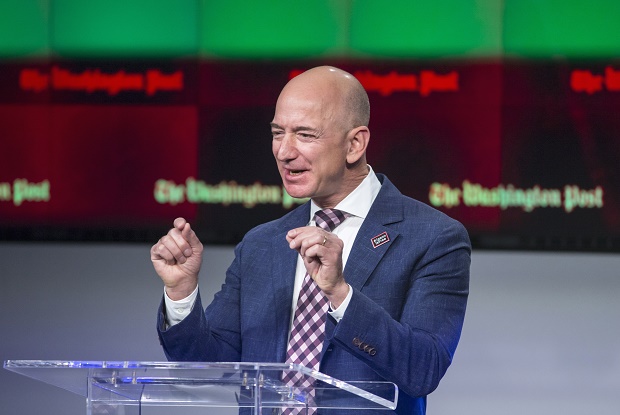
Amazon founder and Washington Post owner Jeff Bezos talks about the history and character of the Post during a dedication ceremony for its new headquarters, Thursday, Jan. 28, 2016, in Washington. AP Photo
WASHINGTON, United States—Under new owner Jeff Bezos, The Washington Post is no longer just a newspaper. It’s reinventing itself as a “media and technology company” that hopes to blaze a trail for newsrooms struggling to transition to a digital era.
The transformation may not be apparent on the surface, but the Internet billionaire has ripped up and revamped the technology underpinnings at the Post since buying the storied daily in 2013, while investing in the newsroom with more journalists, video offerings and tools for digital storytelling.
READ: Jeff Bezos takes control of Washington Post
In a symbolic step, Bezos was present at Thursday’s dedication of the new tech-rich Post headquarters, a few blocks from the musty 1970s building that is being razed.
“I am a huge fan of leaning into the future,” said Bezos, the founder of online giant Amazon who snapped up the struggling newspaper for $250 million in personal funds.
Some of his efforts appear to be paying off.
The Post last year overtook The New York Times in digital visitors, claiming 76 million unique users in December, according to research firm comScore.
That appeared to put it on track toward Bezos’s goal of becoming a new “newspaper of record,” an open challenge to its New York rival.
The growth comes from upgrading all facets of the Post’s digital offerings—with a revamped website and mobile apps, Post content on applications from Facebook and Google, and a Post app pre-loaded onto Amazon Fire and Kindle tablets and offered at a discounted price.
READ: Amazon’s data-driven management approach becoming more common
The Post is also offering its content for free through websites of smaller newspapers around the United States, in a step toward fulfilling its ambition as a national rival to The New York Times and Wall Street Journal.
The Bezos experiment is being closely watched in the industry as newspapers struggle with declining print readership and advertising that pressures the business model of once-lucrative metropolitan dailies.
“The most important thing he has done is give the Post runway—giving the organization a chance to actually take some risks that may not immediately pay off financially,” said Nikki Usher, a George Washington University professor specializing in new media and the future of journalism.
“This has allowed them the freedom to experiment. You see them hiring some of the most talented people in product and business areas, and also doubling down on reporting.”
Know thy customer
Ken Doctor, a media consultant and analyst who writes a blog called Newsonomics, said Bezos is borrowing some of the techniques he used to build Amazon into an online powerhouse.
“Amazon is world class in the customer experience,” Doctor told AFP.
“It has figured out what people want and made that as seamless as possible. And it is Jeff Bezos’s quest to bring that same level of understanding to The Washington Post.”
Doctor said a big part of that strategy is creating a technology “platform”—one that not only performs fast but delivers analytics on how readers are interacting with the website and apps, and also integrates with marketing to deliver targeted advertising and other messages.
The Post platform dubbed “Arc” made its debut in August, and is also being offered to other newspapers to improve their performance and analytics—a move that could according to Doctor help the Washington daily collect useful reader data.
“That’s the roadmap—to learn rapidly about news readers in the same way that Amazon has learned about buyers of goods,” Doctor said.
Bezos upgraded the Post technology team which he said rivals “any team in Silicon Valley.” At the same time, he said he hopes to maintain the strong journalistic tradition at the Post.
He has hired dozens of journalists to bring the newsroom staff up to 700, second only to The New York Times, with more than 1,200.
“We now have a real newspaper fight on,” GWU’s Usher said.
“Bezos has decided he wants to make the Post a national paper and you are starting to see the results of that.”
’22nd century newsroom’
Post publisher Frederick Ryan, hired by Bezos in 2014, told the dedication event that the Post is “a media and technology company” where “journalists work side by side with rock-star engineers” to produce compelling content.
“Our teams are looking ahead to devices and platforms that have not yet been invented,” Ryan said. “We are looking ahead to the newsroom for the 22nd century.”
While Bezos appears to be making strides at the Post, it remains to be seen whether the strategy can be duplicated at other news organizations, many of which lack the same brand recognition and may not have a billionaire owner willing to invest for the long term.
Most US newspapers face a conundrum on digital initiatives that are hard to monetize, while revenues still come largely from print.
Dailies that are part of publicly traded firms, meanwhile, face shareholder pressure for short-term results, often resulting in staff cuts.
“To make it work, you first have to have the commitment to truly changing the business,” said Alan Mutter, a former Chicago newspaper editor who now consults on digital media.
“You have to have confidence and the competence, and then the cash.”
At the Post, Mutter said, Bezos has shifted the focus.
“It’s a work in progress but all of the signs I’ve seen suggest they know what they are doing in how to take an old and respected print brand and adapt it to the new world,” he said.